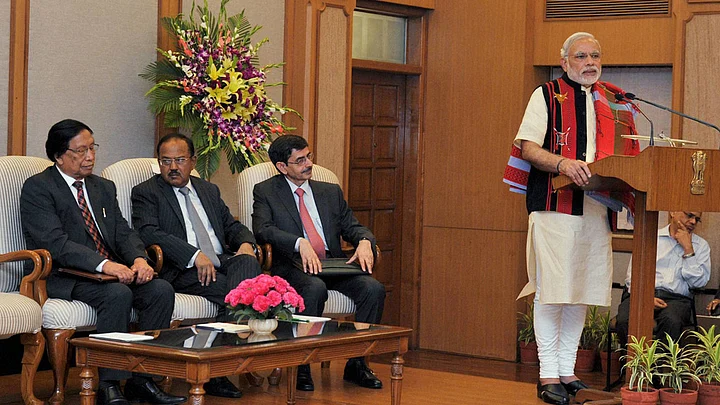The Negotiation
- The most contentious issue of creating a ‘Greater Nagaland’ by integrating all Naga-inhabited areas and redrawing the boundaries of existing states, is off the table
- NSCN (IM) has dropped the demand for territorial integration of the Naga areas spread over Manipur, Assam and Arunachal Pradesh
- The Government of India has acknowledged the ‘unique’ status of the Nagas
- In return for accepting the Naga uniqueness, the Nagas have agreed to work within the ambit of the Indian Constitution
Late on Monday evening, the question uppermost in the mind of every observer who watches the north-east closely was: Will the Naga accord usher in permanent peace in the region, wracked by conflict for decades?
More than 12 hours after the pact was signed between the Government of India and the Issac-Muivah faction of the National Socialist Council of Nagaland (NSCN-IM)—arguably the most influential underground outfit in the region in the past quarter century—the details are as yet unclear. What is however apparent is that both sides have met each other half way to pave way for what is likely to be a major breakthrough in the chequered history of insurgency in India’s north east.
Optimistic Move
There are reasons to be cautiously optimistic. For one, the most contentious issue of creating a ‘Greater Nagaland’ by integrating all Naga-inhabited areas in the region and by consequence redrawing the boundaries of existing states, is off the table. Sources privy to the details of negotiations indicate that the NSCN (IM) has dropped the demand for territorial integration of the Naga areas spread over Manipur, Assam and Arunachal Pradesh—all adjacent states of Nagaland—and has instead settled for ‘cultural’ integration of the Nagas. This will go a long way in allaying fears in neighbouring states about losing territory. Manipur, in particular, has reacted violently to such a suggestion.
Secondly, the Government of India has acknowledged the ‘unique’ status of the Nagas. It has been an article of faith for generations of Naga leaders to be treated as unique. As a government press note said, in the wake of the signing of the accord between NSCN(IM) leader T. Muivah and GoI interlocutor Ravindra Narayan Ravi:
This agreement will end the oldest insurgency in the country. It will restore peace and pave the way for prosperity in the North East. It will advance a life of dignity, opportunity and equity for the Naga people, based on their genius and consistent with the uniqueness of the Naga people and their culture and traditions.
RN Ravi, a former Intelligence Bureau officer with years of experience in the region, also managed to persuade the Naga leaders about climbing down from their demand for ‘sovereignty.’ So in return for accepting the Naga uniqueness, the Nagas have agreed to work within the ambit of the Indian Constitution.
As the government press note said: “The NSCN understood and appreciated the Indian political system and governance.”
The Implications
Once the NSCN(IM) disarms its cadres and some of its leaders join hands with some cultural and political organisations to morph into a political party (a likelihood in medium term), other insurgent groups in the north-east who were dependent on the outfit for sustenance, are also likely to do a rethink on the violent path they currently pursue. Although NSCN(IM)’s rival faction, the Khaplang group, headed by a Burmese Naga, SS Khaplang, is likely to react violently, the government is confident of neutralising the group because of its lack of influence in large parts of Naga areas.
Monday’s agreement has the potential to end a five-decade long conflict that has kept the north-east perpetually on the boil. But for that, both the government and the NSCN(IM) leadership will have to show the same wisdom and sagacity they have displayed in clinching the accord. For, there will be many attempts to derail the hard-won peace in coming months. Therein lies the biggest challenge to the main protagonists of this breakthrough pact.
(The writer is a long-time observer of conflicts in the north-east, based as he was in the region between 1983 and 2006, reporting on various insurgencies there)
(At The Quint, we question everything. Play an active role in shaping our journalism by becoming a member today.)
